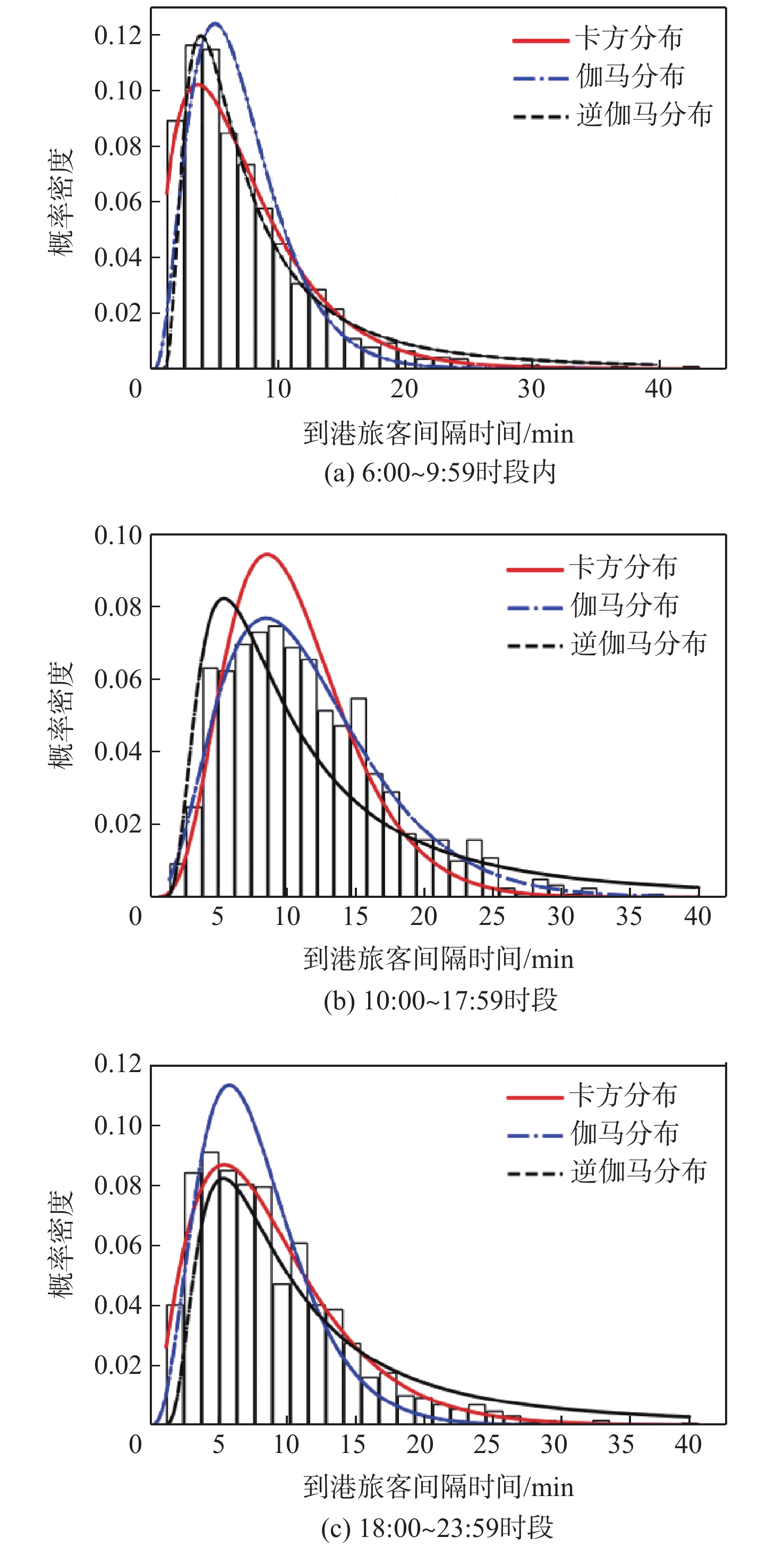-
摘要:
为优化综合交通枢纽服务流程,分析了到港旅客聚集行为动力学特性,研究了到港旅客聚集行为在逆伽马分布、伽马分布与卡方分布时间维度间的转变机制,揭示了聚集行为受航班运行时间与换乘方式效用共同影响,并分别转化为到港旅客时间价值与效用价值。在此基础上,基于逆伽马分布、伽马分布与卡方分布建立了双价值驱动的到港旅客动力学模型,输出为参数可调的到港旅客分布。结果表明:参数可调的仿真输出与真实分布相吻合,为枢纽机场到港旅客分布态势的精准预测提供了方法和依据。
Abstract:In order to optimize the service process of the integrated transportation hub, the dynamic characteristics of the aggregation behavior of arriving passengers were analyzed. The transition mechanism of arriving passenger aggregation behavior between inverse gamma distribution, gamma distribution, and chi-square distribution was studied. It revealed that this aggregation behavior was affected by the flight operation time and transfer mode utility, which was converted into the time value and utility value of arriving passengers, respectively. On this basis, a dynamic model of arriving passengers driven by the dual values was established based on these three distributions, and the output was the distribution of arriving passengers with adjustable parameters. The results show that the simulation output with adjustable parameters is consistent with the real distribution, which provides a method and basis for accurate prediction of the distribution situation of arriving passengers at the airport.
-
Key words:
- human dynamics /
- arriving passengers /
- gamma distribution /
- time value function /
- utility value function
-
表 1 到港航班信息
Table 1. Arrival flight information
航班 到港
时间上轮挡
时间开舱门时间 机位 到港
人数总行
李数1 9:00:00 9:04:00 9:12:20 202 110 52 2 9:07:00 9:10:00 9:13:52 206 173 59 3 9:10:00 9:15:00 9:16:40 202 70 28 ⋮ ⋮ ⋮ ⋮ ⋮ ⋮ ⋮ 表 2 到达口旅客人数
Table 2. Number of passengers at the arrival gate
调查点位 人数 时刻 时段 旅客出口A 旅客出口C 8:10 0~5 min 151 41 5~10 min 183 68 10~15 min 68 114 16:30 0~5 min 121 76 5~10 min 273 132 10~15 min 179 37 18:00 0~5 min 25 116 5~10 min 63 92 10~15 min 100 40 表 3 到港旅客分布拟合参数及拟合度检验
Table 3. Arriving passenger distribution fitting parameters and fit test
时段 卡方分布 伽马分布 逆伽马分布 ν R2 α β R2 α β R2 6:00-9:59 5.544 0.680 1.985 3.644 0.672 1.981 10.102 0.869 10:00-17:59 10.136 0.527 3.564 3.192 0.810 1.746 16.273 0.499 18:00-23:59 7.882 0.786 2.708 3.346 0.676 1.873 12.524 0.637 表 4 时间价值驱动的各参数
Table 4. Parameter driven by the time value
时间感知数值 行李总数均值 B VAPTV b1 L b2 0.9163 0.8602 1.0998 0.6344 3.039 表 5 效用价值驱动的各参数
Table 5. Parameter driven by the utility value
出行方式 费用 时间 舒适度 ξ A a1 M a2 T a3 C 私人交通 0.1 1 0.45 0.5 0.45 1 1 3.653 公共交通 0.8 0.5 0.1 1 0.1 0.5 0.5 表 6 不同分布的仿真拟合与实际拟合的差异程度
Table 6. Degree of difference between simulation fitting and distribution actual fitting of different distributions
评价指标 伽马分布 逆伽马分布 卡方分布 KLD 0.337 0.443 0.257 -
[1] 中国民用航空局. 新时代民航强国建设行动纲要[R]. 北京: 中国民用航空局, 2018: 1-20.Civil Aviation Administration of China. Action plan for building a powerful civil aviation country in the new era[R]. Beijing: Civil Aviation Administration of China, 2018: 1-20(in Chinese). [2] 周涛, 韩筱璞, 闫小勇, 等. 人类行为时空特性的统计力学[J]. 电子科技大学学报, 2013, 42(4): 481-540. doi: 10.3969/j.issn.1001-0548.2013.04.001ZHOU T, HAN X P, YAN X Y, et al. Statistical mechanics of the spatiotemporal characteristics of human behavior[J]. Journal of University of Electronic Science and Technology of China, 2013, 42(4): 481-540(in Chinese). doi: 10.3969/j.issn.1001-0548.2013.04.001 [3] 邢志伟, 冯文星, 罗谦, 等. 基于航班离港时刻主导的单航班离港旅客聚集模型[J]. 电子科技大学学报, 2015, 44(5): 719-724. doi: 10.3969/j.issn.1001-0548.2015.05.014XING Z W, FENG W X, LUO Q, et al. Arrived passenger model in single flight based on the time of departure[J]. Journal of University of Electronic Science and Technology of China, 2015, 44(5): 719-724 (in Chinese). doi: 10.3969/j.issn.1001-0548.2015.05.014 [4] BAO D W, ZHANG T X, TIAN S J, et al. Joint choice model for airport passengers’ travel mode and departure time based on agent theory[J]. Transportation Research Record: Journal of the Transportation Research Board, 2020, 2674(6): 177-187. doi: 10.1177/0361198120918244 [5] FONSECA I CASAS P, CASANOVAS J, FERRAN X. Passenger flow simulation in a hub airport: An application to the Barcelona International Airport[J]. Simulation Modelling Practice and Theory, 2014, 44: 78-94. doi: 10.1016/j.simpat.2014.03.008 [6] 熊红林, 朱人杰, 冀和, 等. 基于MI-SVR模型的航空旅客出行指数预测方法研究[J]. 控制与决策, 2021, 36(7): 1619-1626.XIONG H L, ZHU R J, JI H, et al. Air passenger index prediction method based on MI-SVR mode[J]. Control and Decision, 2021, 36(7): 1619-1626 (in Chinese). [7] 李晓璐, 于昕明, 郗艳红, 等. 基于DBSCAN算法的城轨车站乘客聚集特征分析[J]. 控制与决策, 2019, 34(1): 18-24.LI X L, YU X M, XI Y H, et al. Analysis of passenger aggregation characteristics of urban rail stations based on DBSCAN algorithm[J]. Control and Decision, 2019, 34(1): 18-24 (in Chinese). [8] CHEN J M, DE GROOTE J, PETRICK J F, et al. Travellers’ willingness to pay and perceived value of time in ride-sharing: an experiment on China[J]. Current Issues in Tourism, 2020, 23(23): 2972-2985. doi: 10.1080/13683500.2020.1779190 [9] 刘艳芳. 基于乘客感知价值的可变站点式柔性公交调度研究[D]. 成都: 西南交通大学, 2019: 9-34.LIU Y F. Research on flexible bus scheduling with variable stops based on passengers' perceived value[D]. Chengdu: Southwest Jiaotong University, 2019: 9-34 (in Chinese). [10] 冯霞, 张鑫, 陈锋. 飞机过站上客过程持续时间分布[J]. 交通运输工程学报, 2017, 17(2): 98-105. doi: 10.3969/j.issn.1671-1637.2017.02.011FENG X, ZHANG X, CHEN F. Boarding duration distribution of aircraft turnaround[J]. Journal of Traffic and Transportation Engineering, 2017, 17(2): 98-105 (in Chinese). doi: 10.3969/j.issn.1671-1637.2017.02.011 [11] 白雪莲. 航空旅客通达机场时间可靠性分析[D]. 南京: 南京航空航天大学, 2019: 22-38.BAI X L. Reliability analysis of air passengers' arrival time at airport[D]. Nanjing: Nanjing University of Aeronautics and Astronautics, 2019: 22-38 (in Chinese). [12] BARABÁSI A L. The origin of bursts and heavy tails in human dynamics[J]. Nature, 2005, 435: 207-211. doi: 10.1038/nature03459 [13] YU K. Empirical analysis on human dynamics of sharing-bicycles’ user behavior[J]. Measurement and Control, 2020, 53(3): 1791-1799. doi: 10.1177/0020294020936780 [14] YI M, LU Y Y, DENG W H, et al. Understanding verified users' posting behavior from the perspective of human dynamics: a case study of Sina micro-blog[J]. Aslib Journal of Information Management, 2020, 73(2): 221-239. doi: 10.1108/AJIM-03-2020-0069 [15] 田丽君, 吕成锐, 黄文彬. 基于累积前景理论的合乘行为建模与研究[J]. 系统工程理论与实践, 2016, 36(6): 1576-1584. doi: 10.12011/1000-6788(2016)06-1576-09TIAN L J, LYU C R, HUANG W B. Modelling carpooling behavior based on cumulative prospect theory[J]. Systems Engineering-Theory & Practice, 2016, 36(6): 1576-1584 (in Chinese). doi: 10.12011/1000-6788(2016)06-1576-09 [16] 邢志伟, 文涛, 罗谦, 等. 基于效用价值驱动的旅客出行动力学研究与建模[J]. 北京航空航天大学学报, 2018, 44(2): 250-256.XING Z W, WEN T, LUO Q, et al. Utility value driven passenger travel dynamic study and modeling[J]. Journal of Beijing University of Aeronautics and Astronautics, 2018, 44(2): 250-256 (in Chinese). -








 下载:
下载:




